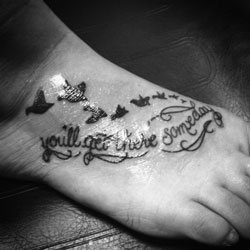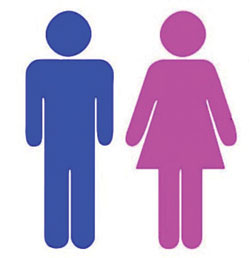In today’s society, tattoos have become more popular and socially accepted. More recently, tattoos have emerged in the media through celebrities and even reality television shows. Tattoos have even become more acceptable in the workplace.
The art of tattooing has always been tied to both cultural and occupational values but not until recently, they were unacceptable in the modern workplace.
Origins of tattoos in the workplace date back to countries such as China and the Philippine Islands.
In China, convicts were inked so anyone passing by the bandit could easily spot them and immeaditely realize they were a criminal. The Philippine Islands had a more positive connotation with tattoos as they were inked in order to show political rankings in their tribes.
Even non-permanent tattoos have lasted throughout time. Henna and Mehndi tattoos, a dye derived from a plant used for temporary tattooing, were created in Ancient India and Egypt. Hennas continue to be popular amongst New Jersey boardwalks.
America’s mainland was introduced to the art of tattoos in the early 1900s when sailors returned home from overseas displaying the inked body art they received while abroad. Even then, tattoos were linked to careers as soliders and sailors painted their arms with ink, which usually was related to America in some way.
In time, tattoos evolved from a tribal tradition into a derogatory form of art according to Associate Professor of Marketing and International Business, David Paul. “At one time, individuals with tattoos were frequently considered to be a part of a group most people did not want to be associated with,” he said. These groups were typically made up of bikers, convicts, or members of freak shows.
Fifty years ago, Paul’s theory would hold true but tattoos have grown immensily poppular as the American culture has embraced the eccentric body art. Tattoos have developed once more as a way for people to express themselves, honor a deceased loved one, or merely as a fun design on the body.
For sophomore business major Kyle O’Grady, tattoos symbolize a story. “I think tattoos are something very personal and should mean a lot. Their main purpose should be to put your life and experiences on you. There should be a story behind them,” O’Grady, who already has one tattoo on her foot, said.
When asked if O’Grady believed tattoos were now acceptable in the workplace, she responded, “I think they have become much more acceptable just because so many people now have them.”
O’Grady is right about the amount of people having them. According to cbsnews.com, 23 percent of college students have tattoos.
On the otherhand, sophomore health education major Mike Kulik held another opinion regarding tattoos in the workplace. “I know for a fact tattoos are not [acceptable in the work place]. As I am pursuing a law enforcement career, new regulations restrict against forearm, face, neck, hand and even lower leg tattoos.”
Freshman business major Christian White sees both the good and the bad in tattoos when it comes to the workplace. “I think it [tattoo policy] depends on what type of workplace and culture the workplace is,” he said.
Communication professor Shannon Hokanson agrees with White’s point of view. “I have four tattoos. I got my first, which has since been covered up, when I was 16,” Hokanson said. “I think the appropriateness of displaying tattoos in the workplace depends greatly on the nature of the profession.”
Although most business firms and work places with a dress code prohibit tattoos to be shown, many other companies such as Bank of America, no longer have formal policies when it comes to their employees having tattoos.
The reason tattoos are seen on the rise more than ever is largely due to the idea of using ink as a medium of expression.
“I express myself with the way I dress and my writing,” freshman communication major Caitlyn Bahrenburg said. “Tattoos are a more permanent version. It’s like being able to see my soul on my skin; I think there is something really beautiful and freeing about that.”
Tattoos are now considered mainstream and accepted in the work place. In current times, professions from doctors’ office receptionists to television news anchors are wearing body art.
Some fuel to the tattoo phenomenon fire can be attributed to reality shows such as “Miami Ink,” “LA Ink” and “Ink Master.” Even the TLC network recently broadcasted a new reality show involving tattoos called America’s Worst Tattoos. The show highlights people across the nation who wish to have their terrible tattoos turned into another image by high quality artists.
If one is looking to add a new body art or is getting inked for the first time, sometimes finding the right artist and tattoo shop is the most crucial part. Some tattoo artists can create incredible art on the body. Just by having a tattoo idea in mind, artists can really bring an idea to life.
Senior criminal justice major Greg Cenicola believes a tattoo should be thought out by the client rather than the tattoo artist. “My rule is print out a picture of it [the design] and hang it somewhere you will see it for a year,” Cenicola said. “If you still love it, you’re good.”
Cenicola, who already has one tattoo, is using this picture tactic as he prepares for his second tattoo. “I already have my next one picked out. It’s a version of St. Michael Angelo, the archangel,” Cenicola said.
A few popular tattoo shops in the area include Fat Kat Tattoos in Keyport, Eternal Tattoos in Howell, and Asbury Tattoo in Asbury Park. Keep in mind that different tattoo artists and parlors specialize in different styles and designs.
Make sure to do research before entering the tattoo parlor because the ink is often a rather expensive investment aside from it being permanent. Also remember that even though America has begun to embrace the tattoo culture, the inked look is not for everyone.
PHOTO COURTESY of Samantha Parent



